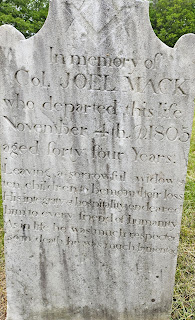Gravestone of James Hendry in Stevens Cemetery
Gravestone of Colonel Joel Mack in Stevens Cemetery.
Gravestones of William Lamb in Stevens Cemetery.
By Liz Page
This week is a good time to review the American Revolution as we prepare to celebrate the "birth of our nation" on July 4, 1776 when Congress passed the Declaration of Independence, establishing the 13 original colonies as legally separate from Great Britain.
The document, largely written by Thomas Jefferson, according to the history books, outlined the reasons the colonies were formally announcing the birth of the United States of America. As history records it, the vote was actually taken on July 2, but the day it was signed has become the official date. Earlier this week, local historian Karen Cuccinello led a tour of the Stamford Cemetery where she talked about the six Revolutionary War veterans buried there.
Tom Giaguzzi, historian for the town of Harpersfield, was also recently talking about the 13 Revolutionary War veterans located in the Stevens Rural Cemetery off Peck Street in the town of Harpersfield.
These were the first veterans of the United States, who walked the local wilderness and fought for our independence.
A vigilance committee was established in Harpersfield and included John, Joseph and Alexander Harper, John Harper Jr., Issac and Freegift Patchin, Andries Riber, William McFarland, St. Leger Cowley, Isaac Sawyer, John More and James Stevens. The cemetery where 13 of the veterans are located is the Stevens family cemetery.
The committee made it their business to learn the aims of the Indians gathering at Windsor. John Harper was commissioned as a colonel of the patriot militia and authorized to embody 200 men to protect the inhabitants in February of 1777.
Joseph Brant was endorsed by the King of England and the settlers of Harpersfield realized they could not combat Brant and his forces on their own and they took refuge at Schoharie and Cherry Valley. They left John More along with a few able-bodied men to harvest the crops.
The men lived wary of their foes in the wilderness from 1777 to 1782. The Sap Bush Raid is one of the prominent skirmishes in the town of Harpersfield as a scouting party was captured and taken to Fort Niagara.
William Lamb and his son, William Jr., were both captured by Brant. Young William was just 12 at the time and became the servant of Molly Brant, sister of Joseph, who lost her own son. The older Lamb was released from Fort Niagara in 1782 after being captured on April 8, 1780.
Many of the inhabitants returned to Harpersfield after the war to rebuild their ruined homes. Lamb and his wife had 11 children.
Not far down the road in the Harper Cemetery you will find the grave of Colonel John Harper, for whom Harpersfield is named. He is described as a frontiersman who played a significant role in the Revolutionary War.
These are the names that appear on the local gravestones as the first veterans of the U.S.. This important history is mapped out by the Harpersfield Historical Society with 11 blue and gold historic markers. A map of their location is available at the HHS museum, next door to the Harpersfield Highway Garage, which is open each Saturday from 11 a.m until 2 p.m. until Labor Day.
William Lamb came to America in 1752 with his parents. His father was described as an ardent patriot and William and his four brothers served in the Revolutionary Army. He served as captain of the 5th Company, 8th Battalion.
You will find his gravestone in the Stevens cemetery. The gravestone acknowledges Lamb's capture and the death of James Stevens, who was killed by the Indians and the Tories on April 8, 1780 as he resisted capture during the Sapbush Massacre. Legend states he killed one of the raiders before his death.
Colonel Joel Mack departed this life on Nov. 4, 1805. He served with the 8th Regiment, Connecticut Militia and James Hendry, killed by Indians andTories in the Sapbush Massacre, with 35 at the time of his death. "While British tyranny overspread this land I was Slain by cruel hands' reads his headstone, also in the Stevens cemetery. Hendry was killed and his brother John Hendry was captured and died a prisoner of war. The three brothers gave their lives for liberty, reads the road marker.
You will also find references to the Sugar Bush Raid on the historic markers that dot the town. The Sugar Bush Raid took place near captives rock where Isaac and Freegift Patchin, along with Ezra Thorp were captured and held until the end of the war. An enemy war party surprised and attacked local militia with three men killed and 10 captured. Lt. Thomas Hendry was killed at his sugar bush camp on the hill above where his burial is marked by a cairn of stones.
Other markers of the raid are located at the site of Samuel Claxton's "Tory House" where the prisoners were held before the long 300-mile journey to Fort Niagara. Captives included Cornelius Teabout, a free black civilian, Walter Elliott and William Turnbull, a local Continental soldier
As we put on our red, white and blue, this July 4th holiday, we should pause a moment to remember those brave men who not only fought to establish a home in the wilderness, but to gain our freedom.`They came to stake out a homestead in the wilderness, but believed in the cause of independence and severing political ties to establish a new nation that would govern itself and provide the right to pursue happiness.
The HHS is open each Saturday or by appointment by calling 607-437-7765. They are in need of volunteers of different skills. You are asked to contact them if you are interested in preserving the area's history.
Remember to Subscribe!







0 comments:
Post a Comment